8.6: Second Empire
- Page ID
- 67086
\( \newcommand{\vecs}[1]{\overset { \scriptstyle \rightharpoonup} {\mathbf{#1}} } \)
\( \newcommand{\vecd}[1]{\overset{-\!-\!\rightharpoonup}{\vphantom{a}\smash {#1}}} \)
\( \newcommand{\dsum}{\displaystyle\sum\limits} \)
\( \newcommand{\dint}{\displaystyle\int\limits} \)
\( \newcommand{\dlim}{\displaystyle\lim\limits} \)
\( \newcommand{\id}{\mathrm{id}}\) \( \newcommand{\Span}{\mathrm{span}}\)
( \newcommand{\kernel}{\mathrm{null}\,}\) \( \newcommand{\range}{\mathrm{range}\,}\)
\( \newcommand{\RealPart}{\mathrm{Re}}\) \( \newcommand{\ImaginaryPart}{\mathrm{Im}}\)
\( \newcommand{\Argument}{\mathrm{Arg}}\) \( \newcommand{\norm}[1]{\| #1 \|}\)
\( \newcommand{\inner}[2]{\langle #1, #2 \rangle}\)
\( \newcommand{\Span}{\mathrm{span}}\)
\( \newcommand{\id}{\mathrm{id}}\)
\( \newcommand{\Span}{\mathrm{span}}\)
\( \newcommand{\kernel}{\mathrm{null}\,}\)
\( \newcommand{\range}{\mathrm{range}\,}\)
\( \newcommand{\RealPart}{\mathrm{Re}}\)
\( \newcommand{\ImaginaryPart}{\mathrm{Im}}\)
\( \newcommand{\Argument}{\mathrm{Arg}}\)
\( \newcommand{\norm}[1]{\| #1 \|}\)
\( \newcommand{\inner}[2]{\langle #1, #2 \rangle}\)
\( \newcommand{\Span}{\mathrm{span}}\) \( \newcommand{\AA}{\unicode[.8,0]{x212B}}\)
\( \newcommand{\vectorA}[1]{\vec{#1}} % arrow\)
\( \newcommand{\vectorAt}[1]{\vec{\text{#1}}} % arrow\)
\( \newcommand{\vectorB}[1]{\overset { \scriptstyle \rightharpoonup} {\mathbf{#1}} } \)
\( \newcommand{\vectorC}[1]{\textbf{#1}} \)
\( \newcommand{\vectorD}[1]{\overrightarrow{#1}} \)
\( \newcommand{\vectorDt}[1]{\overrightarrow{\text{#1}}} \)
\( \newcommand{\vectE}[1]{\overset{-\!-\!\rightharpoonup}{\vphantom{a}\smash{\mathbf {#1}}}} \)
\( \newcommand{\vecs}[1]{\overset { \scriptstyle \rightharpoonup} {\mathbf{#1}} } \)
\( \newcommand{\vecd}[1]{\overset{-\!-\!\rightharpoonup}{\vphantom{a}\smash {#1}}} \)
\(\newcommand{\avec}{\mathbf a}\) \(\newcommand{\bvec}{\mathbf b}\) \(\newcommand{\cvec}{\mathbf c}\) \(\newcommand{\dvec}{\mathbf d}\) \(\newcommand{\dtil}{\widetilde{\mathbf d}}\) \(\newcommand{\evec}{\mathbf e}\) \(\newcommand{\fvec}{\mathbf f}\) \(\newcommand{\nvec}{\mathbf n}\) \(\newcommand{\pvec}{\mathbf p}\) \(\newcommand{\qvec}{\mathbf q}\) \(\newcommand{\svec}{\mathbf s}\) \(\newcommand{\tvec}{\mathbf t}\) \(\newcommand{\uvec}{\mathbf u}\) \(\newcommand{\vvec}{\mathbf v}\) \(\newcommand{\wvec}{\mathbf w}\) \(\newcommand{\xvec}{\mathbf x}\) \(\newcommand{\yvec}{\mathbf y}\) \(\newcommand{\zvec}{\mathbf z}\) \(\newcommand{\rvec}{\mathbf r}\) \(\newcommand{\mvec}{\mathbf m}\) \(\newcommand{\zerovec}{\mathbf 0}\) \(\newcommand{\onevec}{\mathbf 1}\) \(\newcommand{\real}{\mathbb R}\) \(\newcommand{\twovec}[2]{\left[\begin{array}{r}#1 \\ #2 \end{array}\right]}\) \(\newcommand{\ctwovec}[2]{\left[\begin{array}{c}#1 \\ #2 \end{array}\right]}\) \(\newcommand{\threevec}[3]{\left[\begin{array}{r}#1 \\ #2 \\ #3 \end{array}\right]}\) \(\newcommand{\cthreevec}[3]{\left[\begin{array}{c}#1 \\ #2 \\ #3 \end{array}\right]}\) \(\newcommand{\fourvec}[4]{\left[\begin{array}{r}#1 \\ #2 \\ #3 \\ #4 \end{array}\right]}\) \(\newcommand{\cfourvec}[4]{\left[\begin{array}{c}#1 \\ #2 \\ #3 \\ #4 \end{array}\right]}\) \(\newcommand{\fivevec}[5]{\left[\begin{array}{r}#1 \\ #2 \\ #3 \\ #4 \\ #5 \\ \end{array}\right]}\) \(\newcommand{\cfivevec}[5]{\left[\begin{array}{c}#1 \\ #2 \\ #3 \\ #4 \\ #5 \\ \end{array}\right]}\) \(\newcommand{\mattwo}[4]{\left[\begin{array}{rr}#1 \amp #2 \\ #3 \amp #4 \\ \end{array}\right]}\) \(\newcommand{\laspan}[1]{\text{Span}\{#1\}}\) \(\newcommand{\bcal}{\cal B}\) \(\newcommand{\ccal}{\cal C}\) \(\newcommand{\scal}{\cal S}\) \(\newcommand{\wcal}{\cal W}\) \(\newcommand{\ecal}{\cal E}\) \(\newcommand{\coords}[2]{\left\{#1\right\}_{#2}}\) \(\newcommand{\gray}[1]{\color{gray}{#1}}\) \(\newcommand{\lgray}[1]{\color{lightgray}{#1}}\) \(\newcommand{\rank}{\operatorname{rank}}\) \(\newcommand{\row}{\text{Row}}\) \(\newcommand{\col}{\text{Col}}\) \(\renewcommand{\row}{\text{Row}}\) \(\newcommand{\nul}{\text{Nul}}\) \(\newcommand{\var}{\text{Var}}\) \(\newcommand{\corr}{\text{corr}}\) \(\newcommand{\len}[1]{\left|#1\right|}\) \(\newcommand{\bbar}{\overline{\bvec}}\) \(\newcommand{\bhat}{\widehat{\bvec}}\) \(\newcommand{\bperp}{\bvec^\perp}\) \(\newcommand{\xhat}{\widehat{\xvec}}\) \(\newcommand{\vhat}{\widehat{\vvec}}\) \(\newcommand{\uhat}{\widehat{\uvec}}\) \(\newcommand{\what}{\widehat{\wvec}}\) \(\newcommand{\Sighat}{\widehat{\Sigma}}\) \(\newcommand{\lt}{<}\) \(\newcommand{\gt}{>}\) \(\newcommand{\amp}{&}\) \(\definecolor{fillinmathshade}{gray}{0.9}\)Haussmann the Demolisher and the creation of modern Paris
by DR. BETH HARRIS and DR. STEVEN ZUCKER

Paris: Narrow streets and barricades
During each of the previous political revolts (1789, 1830, 1848, and again in 1871), sections of Paris had succumbed to the revolutionaries. These successes were due in part to the political sympathies of the citizens of Paris, but the crooked narrow lanes of the medieval city also played a role. During times of conflict, urban mobs would blockade the maze that was the streets of Paris. Such barricades (makeshift barriers erected across streets to prevent the movement of opposing forces) proved very effective and made Paris all but uncontrollable at times. Think back to Eugène Delacroix’s painting of the revolution of 1830, Liberty Leading the People—Marianne (Liberty) is shown rising over a barricade of just this sort.
Napoleon III and the Second Empire
During the period known as the Second Empire (1852-70), Napoleon III, the great-nephew of Napoleon Bonaparte (emperor of France in the early nineteenth century), ruled France. He asked an administrator, Baron Georges-Eugene Haussmann, to modernize Paris—to bring clean water and modern sewers to the fast growing city, to light the streets with gas lanterns, to construct a central market (Les Halles), and to build parks, schools, hospitals, asylums, prisons, and administrative buildings. But the most ambitious aspect of Haussmann’s plan was to literally reshape the city.

Haussmann’s reconstruction of Paris
For his role in changing the Paris cityscape, Haussmann would acquire the nickname “the demolisher.” He plowed over the ancient, winding streets of the city (the same narrow streets that had proved so useful to revolutionaries). In their place, he created broad straight boulevards that were impervious to the barricade—and, equally important, they could better accommodate the free movement of troops.
The avenues also allowed for the easy flow of commerce and so were a boon for business. Napoleon III had dreamed of a new imperial city whose very streets spoke of the glory of the French empire. Haussmann delivered.

As with nearly every urban renovation, a percentage of the population was displaced. Haussmann forced citizens from their homes as these buildings were torn down to make way for the clean lines of the new city. The wealthy were quickly accommodated. The new boulevards were lined with fashionable apartment houses. It was, as usual, the poor that really suffered.
Charles Garnier, The Paris Opéra
by DR. BETH HARRIS and DR. STEVEN ZUCKER
Video \(\PageIndex{1}\): Charles Garnier, The Paris Opéra, 1860-75
The Paris Opéra (1860-75), designed by Charles Garnier, is one of the jewels of Napoleon III’s newly reconstructed city. Frequented by Degas and the source for much of his ballet imagery, the Paris Opéra is key to understanding the somewhat perverse culture of voyeurism and spectacle among the prosperous classes of the Second Empire.

Marvin Trachtenberg & Isabel Hyman have called the huge Opéra house,
the new cathedral of bourgeois [middle, really upper-middle class] Paris…. The glittering centerpiece of the new Paris….was meant to be much more than a theater in the ordinary sense. For Charles Garnier, an architect of the Ecole des beaux-arts, it was a setting for a ritual in which the spectators were also actors, participants in the rite of social encounter, seeing and being seen.
The division of the structure supports his vision.
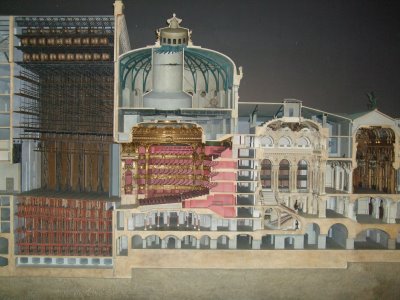
Look at the cross-section. The dome sits above the audience and orchestra, the high roof over the stage. Behind the stage are the rehearsal rooms where Degas often sketched.

But the single largest area, from the front facade to the seats below the dome, is reserved for the foyers and the grand stair hall. This area was, in essence, a second stage. Far more ornate then the performance stage, the lobbies of the Paris Opéra were where the social dramas of the rich were enacted.

Strolling along the new boulevards or posing in the opera’s grand foyers, the ruling classes paraded their wealth. The flâneur, a new denizen of the city, was a man of leisure (itself a by-product of the capital generated by industrialization). Walking the streets not for work or need, but for the pleasures of observation, the flâneur was at home in the Opéra.
Additional resources:
Virtual visit to the Paris Opéra from Google Cultural Institute
Smarthistory images for teaching and learning:

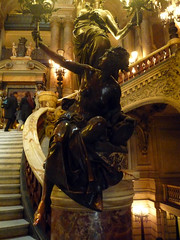
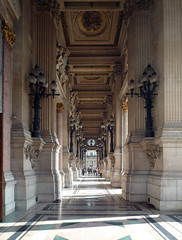

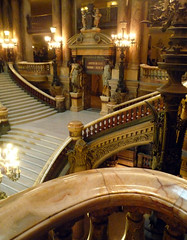
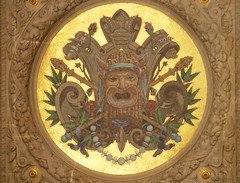
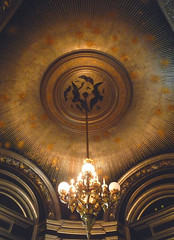
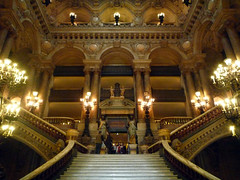

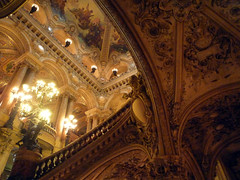

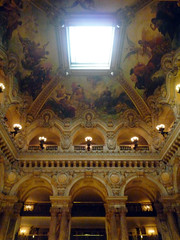
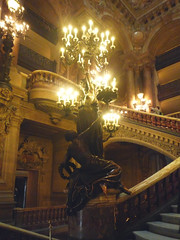
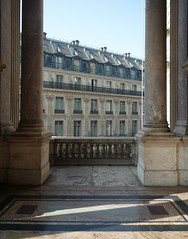
Thomas Couture, Romans of the Decadence
by DR. BETH HARRIS and DR. STEVEN ZUCKER
Video \(\PageIndex{2}\): Thomas Couture, Romans of the Decadence, 1847 (Musée d’Orsay, Paris)


